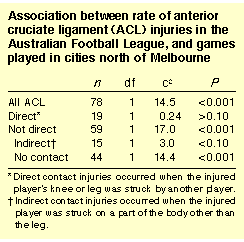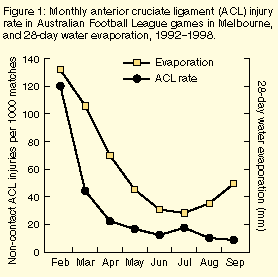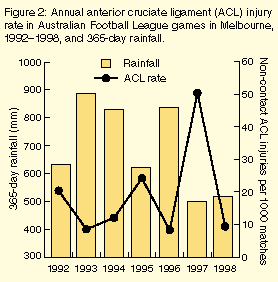|
Research
Rainfall, evaporation and the risk of non-contact anterior cruciate
ligament injury in the Australian Football League
John Orchard, Hugh Seward, Jeanne McGivern and Simon Hood
MJA 1999; 170: 304-306
|
Abstract |
Objective: To determine if weather conditions
affect the risk of anterior cruciate ligament (ACL) tear in
Australian Football.
Design: Prospective observational analytic study of
football matches.
Setting: The Australian Football League (AFL), a
professional competition.
Participants: All players in 2280 matches from
1992-1998.
Main outcome measures: Surgically-proven ACL injury,
not involving a direct contact mechanism, during a match; rainfall;
water evaporation.
Results: 59 ACL injuries not involving direct contact
occurred during the study period, more commonly in cities north of
Melbourne (χ2 = 17.0; df = 1; P <
0.001). Senior grade matches (relative risk [RR], 3.03; 95%
confidence interval [CI], 1.52-6.03), high water evaporation in the
month before the match (RR, 2.80; 95% CI, 1.53-5.10) and low rainfall
in the year before the match (RR, 1.93; 95% CI, 1.12-3.34) were
significantly associated with these injuries.
Conclusion: Low water evaporation and high rainfall
significantly lower the risk of ACL injuries in AFL footballers. The
likely mechanism is a softening of the ground, which lowers
shoe-surface traction. Consistent extra watering and covering of
grounds during periods of high water evaporation may lower the rate of
ACL injuries.
|
| | Introduction |
Anterior cruciate ligament (ACL) injuries of the knee are the most
costly injuries in football at both professional and amateur levels.
Of the commonly occurring injuries, they are the most devastating for
the player, as they usually require reconstruction and long term
rehabilitation in order to retain normal knee function.
In the Australian Football League (AFL), ACL injuries account for 12%
of all missed playing time,1 which costs the competition
over $1 million annually in injury payments alone. The rate of ACL
injury in the AFL competition has increased over recent
years.2
The exact numbers and costs of ACL injuries in amateur football are
unknown. One report that tried to estimate the cost of sports injuries
in Australia3 suggested that the cost of
ACL injuries in all grades and codes of football was at least 10% of the
nation's entire bill for sports injuries. It estimated 5000
football-related ACL injuries in Australia annually, directly
costing $5000 each (not including lost work time and the increased
susceptibility to later knee problems caused by these
injuries).4
Recent studies have noted that there have been relatively more ACL
injuries in the early months of the AFL season, in non-Victorian
games, and in recent seasons of dry weather.2,5 Our aim was to examine the
strength of the relationship of weather conditions to ACL injury.
|
| |
Methods |
We studied 2280 matches (all AFL home and away season, finals, reserve
grade and Ansett Cup matches which occurred from 1992-1998 in the
cities of Adelaide, Brisbane, Canberra, Darwin, Geelong, Hobart,
Melbourne, Perth and Sydney), involving 2239 individual players.
Approximately 75% of the matches were held in Melbourne, 5% to the
south (Geelong and Hobart) and the remaining 20% in the northern
cities.
The occurrence of ACL injuries was determined by an ongoing injury
surveillance program, which has attempted to determine the cause of
every game missed through injury of listed players. The accuracy of
this survey in determining the cause of missed games reached 100% in
1997, and has been greater than 90% in every year.1 In addition, a
separate register for ACL injuries is held by the AFL. ACL injuries in
the AFL are managed surgically and have the diagnosis proven at the
time of simultaneous arthroscopy and reconstruction.
The mechanism of injury was recorded by team doctors and divided into
the categories of direct contact (where the player's knee or leg was
contacted by another player) and no direct contact (which was
subdivided into indirect contact and no contact).
Daily weather variables were measured prospectively (but obtained
by us retrospectively) by the Bureau of Meteorology at central
locations in each city studied. No differentiation was made between
rainfall in the differing suburbs of any city, except for Waverley
Park (30 km from the centre of Melbourne), for which rainfall data were
taken from the nearest centre (Moorabbin). Maximum and minimum
temperature of the day of the match, rainfall, water evaporation and
maximum wind gust were the raw weather variables considered. Water
evaporation is a meteorological variable measuring the change of
surface water into water vapour -- it is affected by temperature,
sunshine, humidity and wind.6 Composite rainfall and
evaporation variables were created (measuring the totals for the
previous 7, 14, 28, 90 and 365 days), which were considered to have had
potentially more effect on ground conditions than the weather only on
the day of the match.
Statistical analysis was carried out using SPSS for
Windows.7 Chi-square and t
tests (after variances assessed using Levene's test) were performed
in the initial stages of the analysis. Multivariate analysis was
performed using a logistic regression forward stepwise technique,
with a significance of 0.05 to enter the equation. Continuous
variables in the logistic regression were redefined into binary
variables based on group median values, to calculate risk ratios
adjusted for confounding.
|
| |
Results |
There were 111 surgically-proven ACL tears recorded in AFL players
during the study period. Excluded from analysis were 33 injuries that
did not occur in AFL matches (13 occurred during practice matches, 14
during training sessions and six in other league matches). Of the 78
injuries in AFL matches, 19 occurred through direct contact, 15
involved indirect contact (to another part of the body than the leg)
and there was no contact involved in 44.
Overall, games played north of Melbourne had a significantly higher
rate of all ACL injuries (Table). However, injuries involving
contact were not significantly associated with being north of
Melbourne, although indirect-contact injuries were more common
north of Melbourne.
For the 59 ACL injuries that did not involve direct contact, the most
predictive rainfall and evaporation variables for ACL injury were
28-day evaporation (t = - 3.8; df = 59; P < 0.001) and
365-day rainfall (t = 1.34; df = 2278; P = 0.18). Other
significant associations were higher grade of match (t = 4.8;
df = 59; P < 0.001), lower minimum temperature (t = -
3.7; df = 59; P < 0.001) and month (fewer injuries in winter)
(t = 3.1; df = 2278; P = 0.002). Non-significant
associations were night games (t = - 1.7; df = 59; P =
0.09) and wind speed (t = - 0.18; df = 2278; P = 0.86).
Although 365-day rainfall was not significant according to the t
test, this variable was entered into the logistic regression
equation as significant. This is because of the confounding effect of
evaporation -- venues with high evaporation also tend to have high
rainfall. In a multivariate analysis including evaporation,
variance in rainfall is more significant than when rainfall is
considered alone. In contrast, night games and minimum temperature
had less significance in the logistic regression model.
All variables were considered in a logistic regression model with
match grade, 28-day evaporation and 365-day rainfall qualifying to
be entered into the equation. Senior grade matches had a 3.03-times
risk of injury compared with reserve grade matches (95% confidence
interval [CI], 1.52-6.03). Matches with high evaporation in the
previous 28 days (> 48 mm) had a 2.80-times greater risk of injury
(95% CI, 1.52-6.03). Matches with low rainfall (< 449 mm) in the
previous year had a 1.93-times greater risk of injury (95% CI,
1.12-6.03).
Figures 1 and 2 illustrate a strong association between the rate of ACL
injuries not involving direct contact and 28-day evaporation and
365-day rainfall, respectively, for the matches in Melbourne over
the study period.
|
| |
Discussion |
Risk factors for injury can be divided into intrinsic (personal) and
extrinsic (environmental). Two intrinsic risk factors for ACL
injury have been established: female sex8-11 and narrowed
intercondylar notch.12-14 In a recent study, both
factors were prospectively followed, and it was concluded that
narrow intercondylar notch accounts for the increased number of ACL
tears seen in female athletes. At this stage, narrowed intercondylar
notch is not a reversible risk factor, but it can be measured at the time
of injury and used to counsel athletes on the risk of recurrence,
particularly to the contralateral knee.
The most promising extrinsic risk factors postulated relate to the
shoe-surface interface. It has been hypothesised for many years that
increasing traction between a football boot and the playing surface
would cause an increase in the rate of knee injuries.15 A recent study
showed that American football boots, with a greater number of cleats
and higher torsional resistance, were prospectively associated
with an increased number of ACL injuries.16
Our results show that high water evaporation in the month before and
low rainfall in the year before an AFL match confer an increased risk of
ACL injury. This relationship is strong for most injuries not
involving contact, but may not apply when the mechanism of injury
involves a direct blow to the knee. The mechanism of this association
is almost certainly through ground-related factors (either soil
moisture content or amount and/or quality of grass). Increased speed
of the game on dry grounds may also be relevant. These results are in
keeping with the theory that excessive shoe-surface traction is a
risk factor for ACL injury. Friction and torsional resistance from
football boots has been shown to be higher in dry conditions on natural
grass compared with wet conditions.17 In a recent review of
non-contact ACL injuries in American Football, it was noted that
almost all injuries on natural grass occurred in dry
conditions,18 but that review did not
measure or control for conditions on days when injury did not occur.
We found that the long term effects of rainfall and water evaporation
(over a period of months) are more relevant than the amount of rainfall
and evaporation on the day or in the days leading up to a match.
Further studies are required to determine the exact mechanism by
which this relationship occurs and what the effects of intervention
would be. The AFL has embarked on a study, beginning with the 1998
season, where matches have ground hardness readings taken with a
Penetrometer, a device used in horse racing to measure track
hardness. Penetrometer results are reliable and correlate with the
speed of races.19 The preliminary results
of the AFL study confirm that low rainfall and high evaporation are
associated with hard (low) Penetrometer readings (< 4.7
cm).20
We did not study differences between ground conditions in coastal and
inland locations, as (except for Canberra) all the major AFL venues
are currently in coastal cities. Further study could include inland
cities, which may experience different ground conditions due to much
colder and drier winters.
Irrespective of their mechanism of action, the effects of high water
evaporation and low rainfall could be reversed on football grounds by
consistently watering grounds during times of lower rainfall and
covering them during times of increased sunshine. If grounds were
prepared in this way to simulate the ground conditions typically
experienced in a Melbourne winter, the number of ACL injuries would
almost certainly be reduced. This is unlikely to lead to an increase in
injuries of other types, as overall injury rates are consistently
higher outside Victoria than in Victoria.1,5 In rugby league in the
United Kingdom, injury rates increased across the board when the
season was changed from winter to summer,21,22 suggesting harder
grounds may be a universal risk factor for football injuries.
In AFL, the main competing concern would be whether games played on
consistently softer grounds would be a lesser spectacle for the
attending and television public. In amateur football, similar
reductions in ACL injuries could probably be achieved, without the
standard of spectacle being an issue. The cost of manipulating ground
conditions might seem initially prohibitive in this environment,
but when the massive cost of ACL injury is considered, great overall
savings could be made.
In conclusion, low water evaporation and high rainfall
significantly lower the risk of non-contact ACL injuries in AFL
footballers. The mechanism is likely to be a softer surface, with
lower shoe-surface traction and consequently less force
transferred to the knee in movements such as pivoting. Consistent
extra watering and covering of grounds during times of high water
evaporation (sunny, windy periods with no rain) is likely to lower the
rate of these devastating and costly injuries.
|
| |
Acknowledgement |
The Australian Football League funds the AFL Injury Surveillance
System from which data for this study were derived.
|
| |
References |
- Orchard J, Wood T, Seward H. AFL injury report 1997. Football
Record 1998; 87: 54-61.
-
Seward H. Can ACL injuries be prevented? In: Australian Conference
of Science and Medicine in Sport. Canberra: Sports Medicine
Australia, 1997.
-
Egger G. Sports injuries in Australia: causes, costs and
prevention. Sydney: National Better Health Program, 1990.
-
Deacon A, Bennell K, Kiss ZS, et al. Osteoarthritis of the knee in
retired, elite Australian Rules footballers. Med J Aust
1997; 166: 187-190.
-
Orchard J, Seward H, Garlick D. Ground conditions and AFL injuries.
In: Australian Conference of Science and Medicine in Sport.
Canberra: Sports Medicine Australia, 1997.
-
Lewis R, editor. Meteorological glossary. 6th ed. London: HMSO
Publications, 1991.
-
SPSS for Windows [computer program]. Version 6.0. Chicago, Ill:
SPSS Inc, 1992.
-
Arendt E, Dick R. Knee injury patterns among men and women in
collegiate basketball and soccer. NCAA data and review of the
literature. Am J Sports Med 1995; 23: 694-701.
-
Ferretti A, Papandrea P, Conteduca F. Knee ligament injuries in
volleyball players. Am J Sports Med 1992; 20: 203-207.
-
Gray J, Taunton J, McKenzie D. A survey of injuries to the anterior
cruciate ligament of the knee in female basketball players. Int J
Sports Med 1985; 6: 314-316.
-
Bjordal J, Arnoy F, Hannestad B, Strand T. Epidemiology of
anterior cruciate ligament injuries in soccer. Am J Sports Med
1997; 25: 341-345.
-
Souryal T, Moore H, Evans J. Bilaterality in anterior cruciate
ligament injuries: associated intercondylar notch stenosis. Am
J Sports Med 1988; 16: 449-454.
-
Shelbourne K, Facibene W, Hunt J. Radiographic and
intraoperative intercondylar notch width measurements in men and
women with unilateral and bilateral anterior cruciate ligament
tears. Knee Surg Sports Traumatol Arthrosc 1997; 5: 229-233.
-
Shelbourne K, Davis T, Klootwyk T. The relationship between
intercondylar notch width of the femur and the incidence of anterior
cruciate ligament tears: a prospective study. Am J Sports Med
1998; 26: 402-408.
-
Torg J, Quendenfeld T, Landau B. The shoe-surface interface and
its relationship to football knee injuries. J Sports Med
1974; 2: 261-269.
-
Lambson R, Barnhill B, Higgins R. Football cleat design and its
effect on anterior cruciate ligament injuries: a three year
prospective study. Am J Sports Med 1996; 24: 155-159.
-
Heidt R, Dormer S, Cawley P, et al. Differences in friction and
torsional resistance in athletic shoe-turf surface interfaces.
Am J Sports Med 1996; 24: 834-842.
-
Scranton P, Whitesel J, Powell J, et al. A review of selected
noncontact anterior cruciate ligament injuries in the National
Football League. Foot Ankle Int 1997; 18: 772-776.
-
Neylan J, Stubbs A. Assessing racetrack conditions: a review of
available devices. Canberra: Rural Industries Research &
Development Corporation, 1998.
-
Orchard J. Measurement of football ground hardness using the
racetrack Penetrometer [abstract]. Med Sci Sports Exer. In
press, 1999.
-
Hodgson Phillips L, Standen P, Batt M. Effects of seasonal change
in rugby league on the incidence of injury. Br J Sports Med
1998; 32: 144-148.
-
Gissane C, Jennings D, White J, Cumine A. Injury in summer rugby
league football: the experiences of one club. Br J Sports Med
1998; 32: 149-152.
(Received 30 Jul, accepted 28 Nov, 1998)
|
| | Authors' details |
Sports Medicine Unit, University of New South Wales, Kensington,
NSW.
John Orchard, MB BS, FACSP, Visiting Fellow.
Australian Football League Medical Officers Association,
Melbourne, VIC.
Hugh Seward, MB BS, FACSP, President;
Jeanne McGivern,
MB BS, FRCS, Club Medical Officer;
Simon Hood,
BAppSci(PE), Research Officer.
Reprints: Dr J Orchard, South Sydney Sports Medicine, 111 Anzac
Parade, Kensington, NSW 2033.
Email:
johnorchardATmsn.com.au
Make a
comment
| |
Journalists are welcome to write news stories based on what they read here, but should acknowledge their source as "an article published on the Internet by The Medical Journal of Australia <http://www.mja.com.au>".
<URL: http://www.mja.com.au/>
|
| |

Back to text

Back to text

Back to text
|
|







